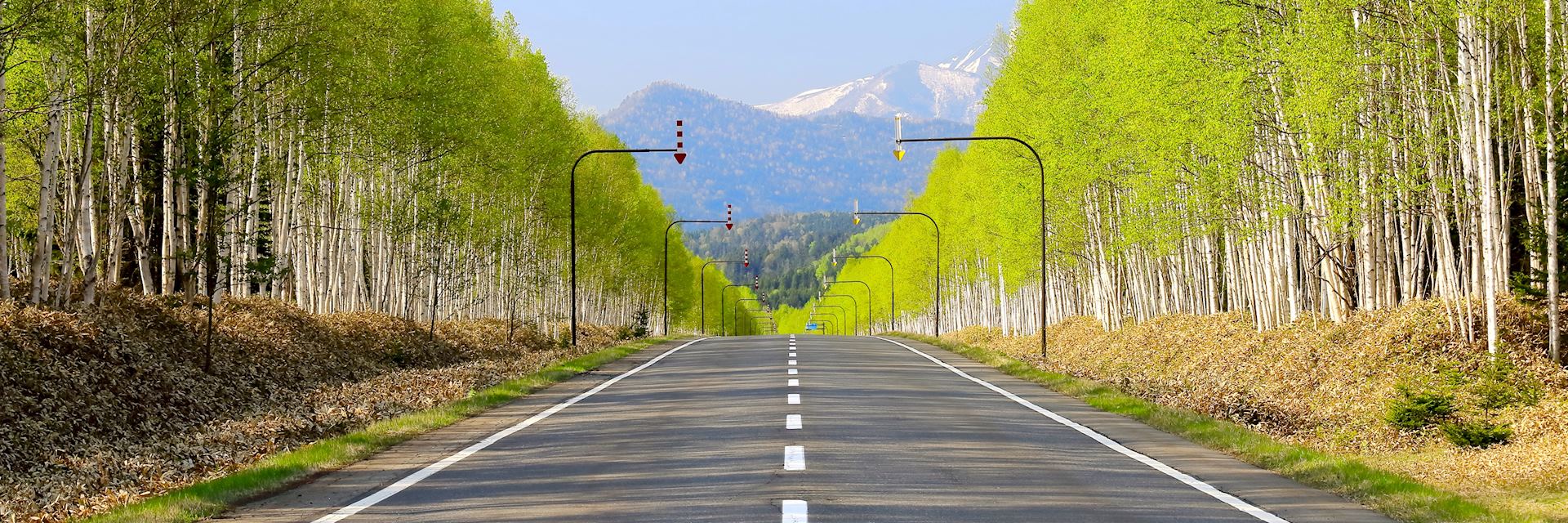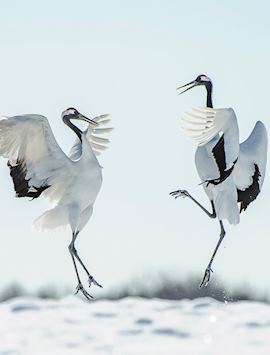By Audley Japan specialist Toby
Only officially part of Japan since 1869, Hokkaido is home to just 5% of the population. The country’s second-largest island is the antithesis of people-packed Tokyo. Wild, open grasslands, primeval forests and jewel-hued lakes replace streams of the populace on the go. It’s Japan’s final frontier, where bears roam and sea lions thrive.
As public transport is lacking, self-driving is the best way to explore. You’ll spend your trip driving along traffic-free, smooth stretches of tarmac that sweep between forested volcanoes, farmland and candy-striped flower fields.
You can spend a few weeks crossing the entire island, or fly into one of the many regional airports to explore a smaller area. If you’re a first-time visitor to Japan, I’d advise adding in time on the main island of Honshu if you want to see Japan’s temples, gardens and architecture; Hokkaido has its own traditions.
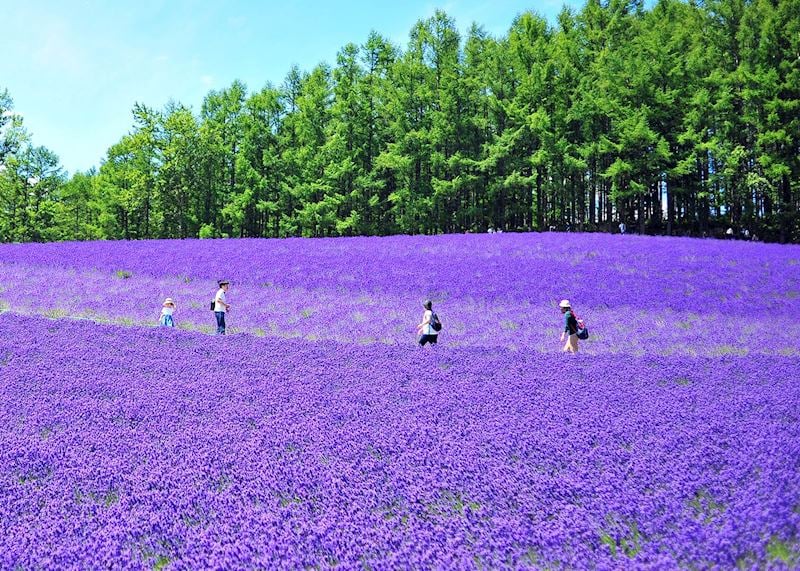
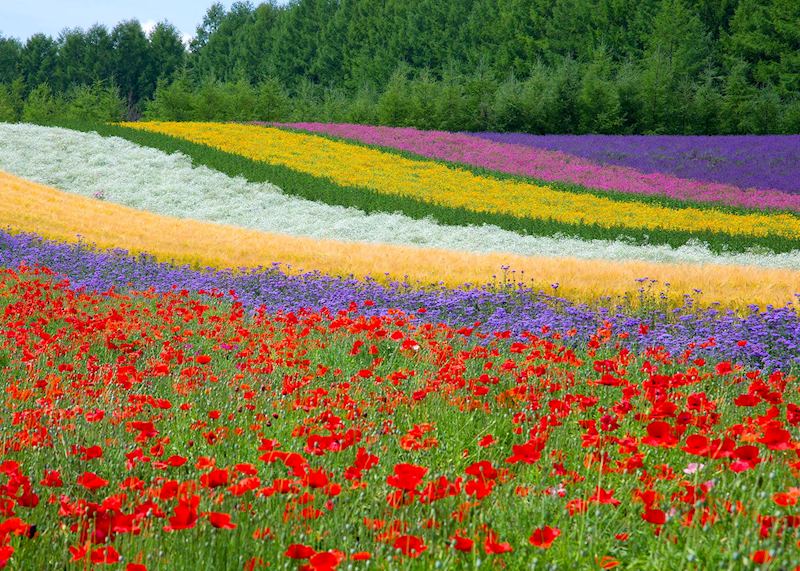
Getting to Hokkaido
With more than ten domestic airports scattered across Hokkaido, you can catch a short flight from Tokyo to a choice of starting points. These tiny regional airports run to Japanese levels of efficiency: within 15 minutes of landing, I had my bag in hand and was walking out the door.
For a more dramatic journey, you can catch the bullet train from Tokyo to Hakodate on Hokkaido’s southern coast. Taking just over four hours and covering 825 km (513 miles), along the way the train hits speeds of 260 km/h (162 mph) and passes through the undersea Seikan Tunnel.
Where to visit on Hokkaido
I flew from Tokyo to Kushiro, an eastern city on Hokkaido, and spent a few weeks driving west across the island to Hakodate. You don’t have to explore everything I did on one long trip: it’s also possible to create smaller, circular routes that focus on your interests.
Akan National Park

From Kushiro (I skipped straight out of this quiet port city), the smooth Mashu National Highway leads directly to Akan National Park. Within a couple of hours, you’re surrounded by patches of Sakhalin fir trees and wide-girth yezo spruce. Clumps of rhododendron encroach the road as it skirts gently sloping volcanic mountains: you’re a long way from the just-so manicured version of Japan.
The park is laid out around three glassy caldera lakes, and the wide, grassy landscape is scored with well-marked walking trails. The Tourist Information Centre at Lake Akan has good information on the routes and the peaks you can scale.
If you’re after a slower pace, there are a number of hot springs around the edge of Akan Lake where you can pull over the car to take a dip. A more rustic affair than bathing in an onsen, these natural pools are for mixed-sex use and swimwear is accepted (it’s often banned in single-sex baths). There’s usually a small changing room nearby. Edged in rounded boulders that separate the hot spring from the main lake, the water is glass-clear and can reach around 40°C (104°F).
Where to stay in Akan National Park
By and large, most places to stay on Hokkaido have been built in a large resort style and seemingly attempt to use as much concrete as possible. But there are a few notable exceptions, including the Hinanoza.
The hotels on Hokkaido are relatively modern and you won’t find heritage ryokan, but the Hinanoza has managed to recreate a traditional ambiance with classical paintings, wood carvings, tatami matting and an onsen.
Shiretoko National Park
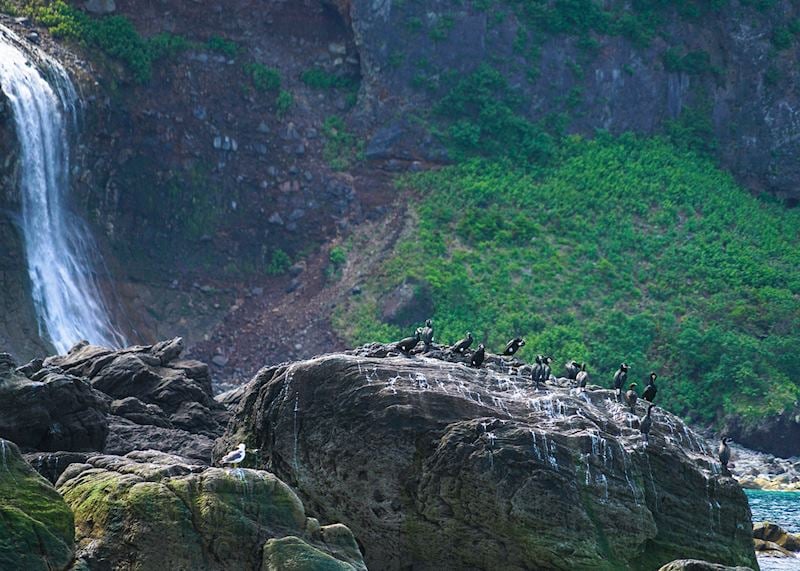
In the local Ainu language, shiretoko means ‘the end of the earth’, and the name still feels apt. Shiretoko National Park is a volcanic peninsula with a dark-green covering of primeval fir forest that hosts a healthy brown bear population. It’s one of the remotest parts of Japan, with a single road traversing the outskirts.
From Akan, it’s about a three-hour drive to reach the fishing port of Utoro on the west of the peninsula. While you can take guided hikes into the forest, often the most successful wildlife-spotting is from the sea.
From Utoro, you can take a boat cruise that hugs the steep cliffs and inlets of the peninsula’s coastline. As we rounded the coast, the bluffs gave way to rocky beaches and we immediately saw our first bear, followed by two bumbling cubs.
On land, you’d need to scarper from a mother and her cubs, but here you can bob in the water, watching from a respectful distance. I suggest bringing binoculars and a long-lens camera to make the most of the experience.
Along the peninsula’s east coast, the ocean floor plummets to a deep-sea valley. The geothermally warmed waters are an ideal swimming ground for whales and sea lions. From the nearby town of Rausu, I boarded a whale watching boat to try and catch a glimpse.
You know you’re on a good trip when even the crew get excited. There are whales in the area year-round and, depending on when you travel, you might see humpbacks, minkes or orcas. Minke whales are usually solitary animals, but we saw pods of them sweeping through the water. It was a rare sighting, as the crew were eager to confirm, and only seen during mating season.
Where to stay in Shiretoko National Park
The Shiretoko Grand Hotel Kitakobushi is the best of a relatively generic bunch of hotels in Utoro, but it’s right at the entrance to the park with a roof terrace looking out over the Sea of Okhotsk. The buffet restaurant gives you a good opportunity to try Japanese delicacies.
The Ainu people of Hokkaido
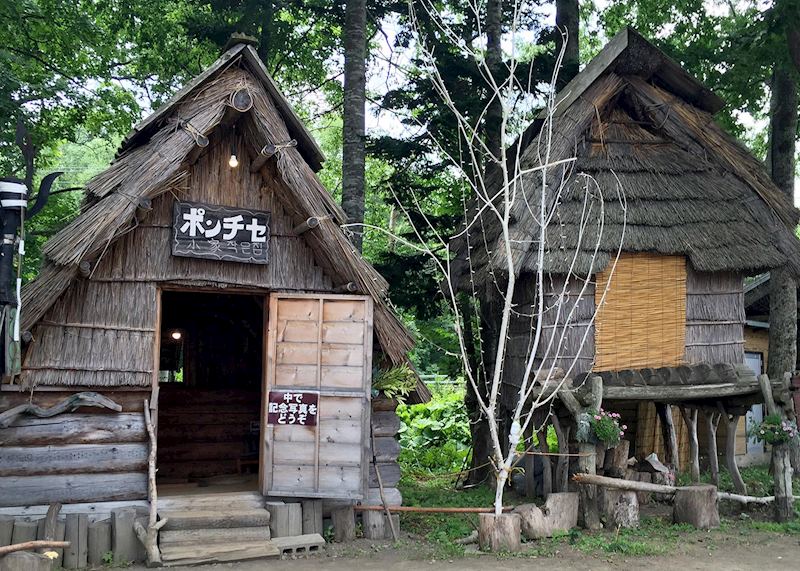
Driving out of Shiretoko, there’s the chance to stop at the Hokkaido Museum of Northern Peoples in the town of Abashiri. Hokkaido is the heartland of the indigenous Ainu people. Skilled hunters, they had an animistic belief system and strong storytelling traditions. Physically very distinct from the Japanese with bushy beards and lighter skin, recent genetic research has indicated their Mongolian origins.
As the Japanese began to settle on the island in the 1600s, the Ainu were required to learn Japanese and adopt Japanese names. But, in 2008 they were officially acknowledged as an indigenous group, and a number of museums have been created to preserve their culture. While the museum dodged the controversial history of the Ainu, it was an insightful look at their beliefs (for one, that the world was created on the back of a giant trout) and way of life.
Daisetsuzan National Park
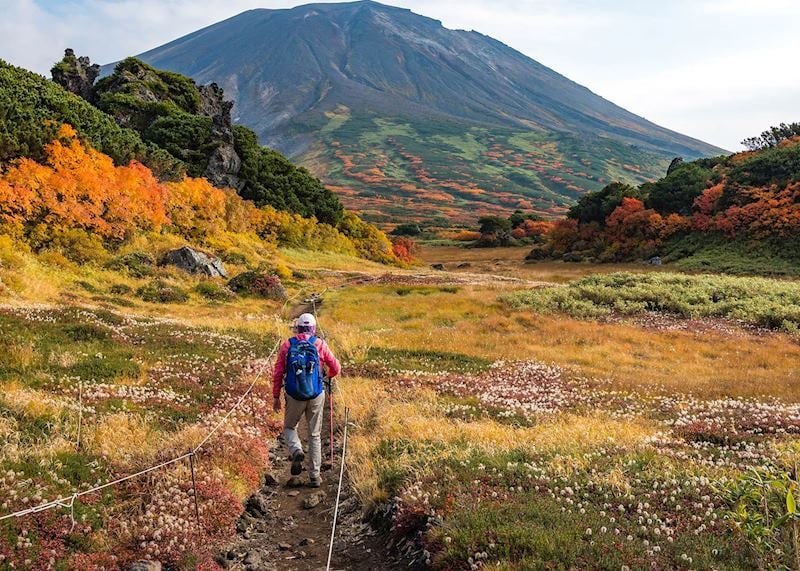
Japan’s largest national park lies like a crumpled piece of paper in the middle of the island, its huge rifts and valleys caused by millennia of volcanic activity. The peaks, which nudge 2,000 m (6,560 ft), tend to stay topped with snow, while the thick, shrubby undergrowth is among the first in Japan to turn autumnal.
Driving toward the park from Shiretoko only takes a few hours, as you pass through flat arable farmland. The main produce here is wheat and livestock — which are too space-consuming for the rest of Japan to consider.
More mountainous than Hokkaido’s other national parks, Daisetsuzan has a wide variety of hiking trails. Follow one of the low valley routes and you stand a chance to see Ezo deer, fish owls and the rare alpine butterfly. The higher trails are often trimmed with tiny white chinguruma flowers and cross waterfalls created by the melting snowline.
If you’re eager to summit a peak, Mount Asahidake is a surprisingly accessible, non-technical climb (there’s even a cable car halfway up, if you don’t want to tackle the whole route).
Where to stay in Daisetsuzan National Park
A few spa towns perch around the periphery of the park, where I suggest you allow a few nights to explore. Hotel Taisetsu, in the village of Sounkyo, is in the base of a steep gorge. You have the Sounkyo Hot Spring on your doorstep, as well as a cable car that will take you up the side of Mount Kurodake.
Sapporo
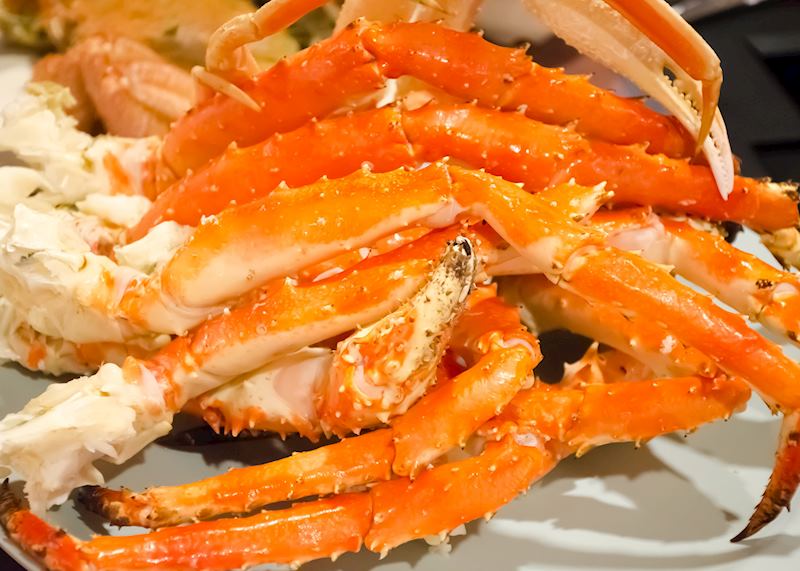
The drive from Daisetsuzan to Sapporo, Hokkaido’s biggest city, only takes a few hours, but I’d put aside a full day to make the most of opportunities to stop along the way. As you drive from east to west, the landscape feels progressively more Japanese, with suburban rice farms lining the roadside.
The road passes through Furano, a rural town where most of Japan’s lavender is cultivated (visit from June to August to see the fields in bloom). Continuing on, you reach the town of Biei. Here, a rainbow of red poppies, white baby’s breath and yellow petunias streak across the hills. Most of the flower farms welcome visitors and have a café or restaurant.
It’s worth spending a couple of nights in Sapporo as an antidote to the rurality of the rest of the island. Sapporo’s a little thin on the ground when it comes to sights, but it has a thriving food scene.
According to some Japanese friends, the crab served here is the best in the world, and I can definitely agree it’s the best I’ve had.
The crabs are simply pot-boiled whole, sliced open and then placed in front of you. Horsehair crab (about the size of a lobster) is most common, but you’ll also see menus with king crab, which can grow to the size of a large dining table.
Jingisukan is another speciality of the region: grilled mutton accompanied by a rich broth to pour over it. It’s a difficult dish to find elsewhere in Japan, where lamb is rarely eaten.
Where to stay in Sapporo
The city’s hotels are predominantly focused on business guests, and providing modern and efficient facilities. I’d pick out the JR Tower Hotel Nikko Sapporo for its central location, spa and views across the city.
Shikotsu-Toya National Park
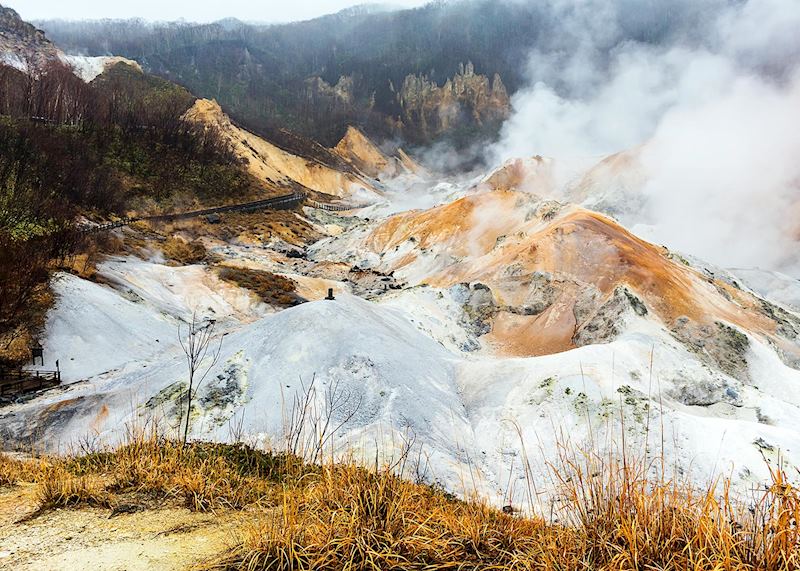
From Sapporo, you can fly back to Honshu. But if you want to explore further, or catch the bullet train back from near Hakodate, I recommend adding Shikotsu-Toya National Park to your itinerary (it’s also an alternative to the island’s eastern parks).
The park has the obligatory hot springs, and hiking and cycling trails, but the active sulphur vents scored into the landscape between the alpine forests take this particular wilderness up a notch.
The aptly named Jigokudani (‘Hell Valley’) is the most dramatic: a huge scar runs through the wooded valley, plumes of sulphur bubbling from black mud pools. From the nearby car park, you can follow a marked trail to a series of viewing platforms.
Where to stay in Shikotsu-Toya National Park
Mizu no Uta is a modern, ryokan-style hotel on the shores of Lake Shikotsu, one of the park’s caldera lakes. Some of the rooms come with a private onsen that overlooks the surrounding pine forest.
When to drive through Hokkaido
Snowbound for half the year, it’s worth waiting until June to visit Hokkaido when the last of the drifts have melted.
During June and July, you’re likely to see the majority of the flowers in bloom, as the weather gradually peaks to around 25°C (77°F) in August.
In September and October you’ll catch the leaves turning autumnal. By November, the snow has usually hit and attractions begin to close.
If you’re not driving, you can also visit Hokkaido in February for the Sapporo Snow Festival.
Start planning your trip to Hokkaido in Japan
Start thinking about your experience. These itineraries are simply suggestions for how you could enjoy some of the same experiences as our specialists. They’re just for inspiration, because your trip will be created around your particular tastes.
View All Tours in Japan
